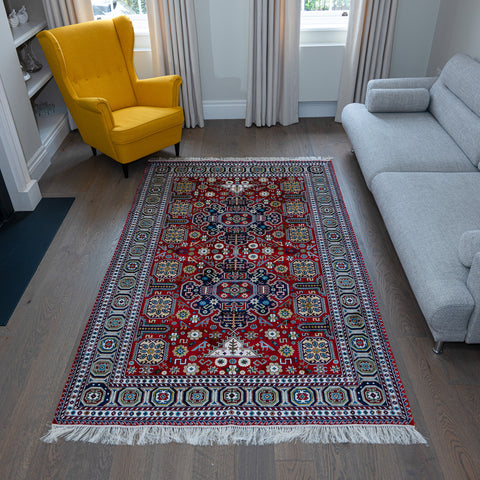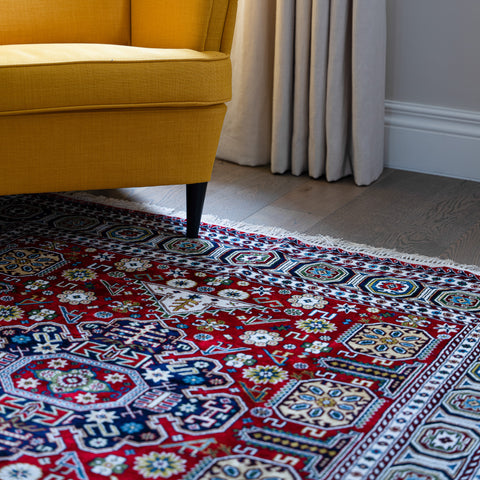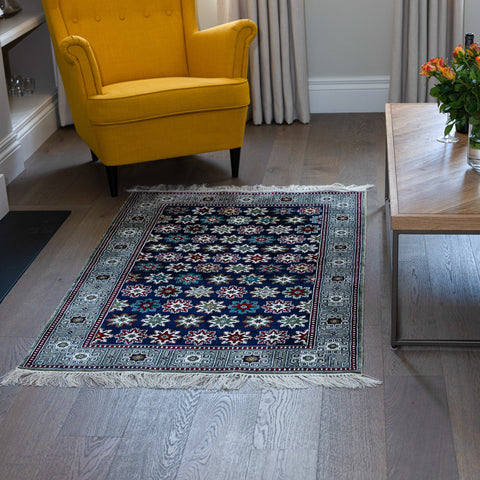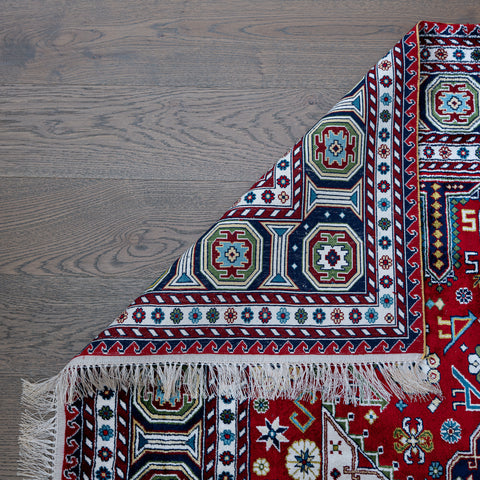Underfloor heating with carpet

Underfloor heating and carpets can actually be a great combination, offering both warmth and comfort. But it's important to approach this pairing with a bit of care. Not all carpets are suited for use with underfloor heating, and the right choices will ensure you get the most out of your heating system while still enjoying the feel and appearance of your carpet.
When selecting a carpet for use with underfloor heating, you need to consider the type of carpet, its thickness, and the underlay. Carpets that are too thick or made from dense materials can inhibit heat flow, reducing the efficiency of your heating system. Opt for a carpet with a low tog rating and ensure that the underlay is suitable for underfloor heating as well.
By making the right choices, you'll enjoy a warm, cozy floor without sacrificing style or comfort. So, let’s dive into the details and make sure you get the best out of both your carpet and your underfloor heating.
A little about underfloor heating
Underfloor heating is a clever and efficient way to warm up your home, and while it may sound a bit fancy, it's really quite practical and comfortable, especially in the colder months.
There are two main types of underfloor heating: wet and electric.
The first one, wet underfloor heating, involves a system of pipes installed under the floor. These pipes circulate warm water, typically heated by a boiler. The great thing about this system is that it provides even heat distribution across the room, and the warmth rises gently, creating a comfortable, consistent temperature without the need for bulky radiators. It's also quite energy-efficient and ideal for larger areas or whole-home heating.
The second type, electric underfloor heating, uses electric cables or mats that are installed beneath the floor surface. This system is often quicker to install and is ideal for smaller spaces or for use in specific rooms like bathrooms or kitchens. It heats up faster than wet systems, but it can be a bit more expensive to run.
Both systems are great for creating a cozy atmosphere, but you’ll want to ensure the flooring and the heating system are compatible, especially when it comes to using carpets. Keep in mind that you’ll need a carpet with good thermal conductivity to allow the heat to rise effectively.

Now, when it comes to pairing carpets with underfloor heating, there are a few things to keep in mind to make sure everything works smoothly. The key is choosing the right carpet – one that allows the heat to flow through and keeps your feet comfortable without over-insulating the floor.
Here’s what you need to know:
1. Carpet Thickness: Thicker carpets can sometimes trap the heat, preventing it from rising effectively. Opt for carpets that are relatively thin or have a lower pile height if you're planning to use them with underfloor heating. This allows the heat to pass through more easily.
2. Material Matters: Wool carpets, for example, can be insulating, but they’re also quite breathable and can work well with underfloor heating. On the other hand, synthetic carpets (like nylon or polyester) tend to be better at allowing heat to pass through. If you're not sure about the materials, look for carpets specifically labeled as suitable for use with underfloor heating systems.
3. Carpet Underlay: The underlay plays a big role too. Choose one that’s compatible with underfloor heating. Some underlays can block the heat, making it harder for the warmth to rise, so go for a thinner underlay that’s designed for this kind of setup. You’ll still want a bit of cushioning, but make sure it’s the right type.
4. Flooring Compatibility: Not all floors are suitable for underfloor heating, so make sure your flooring is compatible. Wood, stone, and tile are great because they allow heat to rise and spread evenly. If you're laying a carpet, it’s important that it’s suitable for use with your specific heating system.
So, while underfloor heating and carpets are a great combination for comfort and warmth, it’s essential to choose wisely to ensure that everything works as it should. With the right carpet and underlay, you'll get the best of both worlds – a cozy, warm floor without sacrificing comfort or efficiency.
How to choose a carpet for underfloor heating?

Not all carpets are made the same, and when it comes to underfloor heating, finding the right one is key. Too thick, and you'll block the warmth; too thin, and you'll lose it all. It's about striking the perfect balance.
Here’s what to look for:
1. Tog Rating: This measures insulation. For underfloor heating, aim for a combined carpet and underlay tog rating of no more than 2.5. Anything higher will trap the heat, making the system less efficient.
2. Material: Choose materials that let the heat through while still feeling cozy. Wool blends with synthetic fibres are great—they offer warmth without blocking heat.
3. Thickness: Go for a carpet that's neither too thick nor too thin. A middle ground works best for allowing heat to pass through.
4. Underlay: Opt for a low-tog underlay specifically designed for underfloor heating. It helps maximise the system’s efficiency.
By paying attention to these factors, you'll have a stylish and cozy floor that works perfectly with underfloor heating. It’s all about making smart choices that bring both warmth and comfort.
How do you Install Carpet Over Underfloor Heating?

Step 1: Check the Heating
Before you start laying down the carpet, make sure your underfloor heating is working properly. Test it out and make sure everything's functioning as it should. If there are any issues, now’s the time to fix them. You don’t want to cover up a faulty heating system with your new carpet.
Step 2: Get the Underlay Right
Remember when we talked about underlay? Now’s the time to use it. Choose a low-tog underlay designed for underfloor heating, and lay it down evenly, trimming as needed to fit the space. Make sure it’s smooth and flat – it’s like creating a comfortable base for your carpet.
Step 3: Roll Out the Red Carpet (or Whatever Colour You've Chosen)
Now, the fun part – roll out your carpet and make sure it's laid straight. Trim the edges carefully so it fits perfectly. Take your time with this step; rushing could result in an uneven finish, and nobody wants that.
Step 4: Securing Your Carpet in Place
Once everything is laid out and looking good, it's time to secure it in place. Use a strong adhesive that's meant for carpeting, and apply it carefully. You don’t want the carpet shifting over time. Press it down evenly, ensuring it’s firmly stuck, then step back and admire your work. Job well done!
Step 5: Hold on a Moment
Before you turn up the heating, give everything some time to settle. Let the adhesive dry properly and let the carpet settle into place. It’s best to wait a day or two before cranking up the heat, just to ensure everything is secure and ready to go. Time for a cuppa while you wait!
Step 6: Enjoy!
And now for the best part—turn on the heating, feel that lovely warmth coming through, and take a moment to appreciate your work. You've just installed a carpet over underfloor heating, and it looks great!
It wasn't too tricky, was it? With a bit of patience and the right approach, you've got a floor to be proud of. And remember, if you're ever unsure, there's no harm in calling in a professional. Sometimes it's worth getting an expert to ensure everything’s done properly. But go ahead and give it a go— you might surprise yourself!
What is the maximum temperature for underfloor heating?
Let's get straight to it – the ideal temperature for under carpet heating is around 27°C. Too hot, and you'll be turning your living room into a sauna, which could damage the carpet and make it look worn out over time. Keep it even, with no hot or cold spots, and you'll have that perfect, cozy warmth for your feet all year round. So, 27°C is your sweet spot – not too hot, not too cold. Keep it there, and you're all set!
Do you need to use under carpet heating thermostat?
Using a thermostat with under carpet heating is a real game-changer! It's like having a remote control for your warm floors. Set it to your perfect temperature – around 27°C – and let it do all the work. Whether you're out or at home, this handy gadget will keep your floors just the way you want them, with no hassle. It's like having a personal foot-warmer that knows exactly what you need. Once you get one, you'll wonder how you ever managed without it. It’s a must-have!
Is it safe to use underfloor heating and carpets?
Underfloor heating and carpet can work perfectly together, as long as you do it properly. Choose a carpet that’s not too thick and make sure the underlay is suitable. Follow the guidelines for both the carpet and the heating system, and you’ll be fine. With the right setup, you’ll get even, controlled warmth and a safe, comfortable environment. Just make sure you're using quality materials, and you'll be all set to enjoy the benefits.
Conclusions
Carpets and underfloor heating can be a perfect combination when done properly. With the right carpet, underlay, and system, you'll have a warm, comfortable space that looks great too. Just take your time, follow the guidelines, and you’ll enjoy a cozy floor all year round. It’s really worth it when everything comes together.

We’ve covered everything from how underfloor heating works to the best way to pair it with carpets. It’s all about making smart choices, from selecting the right carpet to ensuring the installation goes smoothly. With the right setup, you’ll have a warm, cozy home without any of the hassle. The key takeaway? Carpets and underfloor heating can be the perfect combo if you get the details right. Take your time, follow the steps, and you’ll have a comfortable and stylish space to enjoy.
FAQ
Q1: Can I use any type of carpet with underfloor heating, or are there specific ones I should look for?
A1: No, not all carpets will do. You'll want to aim for carpets with a combined tog rating of no more than 2.5 with the underlay. A mix of natural fibres like wool with some synthetic material is usually a safe bet. Too thick, and you'll block the warmth; too thin, and the heat might escape. It's about getting the balance right.
Q2: How do I know if my underfloor heating is working properly before I lay down the carpet?
A2: It's essential to test your underfloor heating system before laying down the carpet. Give it a run, and make sure it's heating evenly without any cold spots or unusual fluctuations. If you're unsure, it might be wise to get a professional to take a look before you proceed with the carpet installation.
Q3: What's this tog rating you keep mentioning, and how do I find the right one for my underfloor heating?
A3: The tog rating is a measure of how well something insulates. For underfloor heating, you'll want a combined tog rating (carpet and underlay together) of no more than 2.5. This ensures the heat comes through without getting trapped.
Q4: Is it possible to DIY the installation of carpet over underfloor heating, or should I call in a professional?
A4: While it's possible to DIY the installation, it's a job that requires careful attention to detail and adherence to guidelines. If you're confident with home improvements and follow the instructions carefully, you could give it a go. But if you're unsure, calling in a professional ensures it's done right, which might save you headaches down the line. It's all about knowing your comfort level and abilities.


